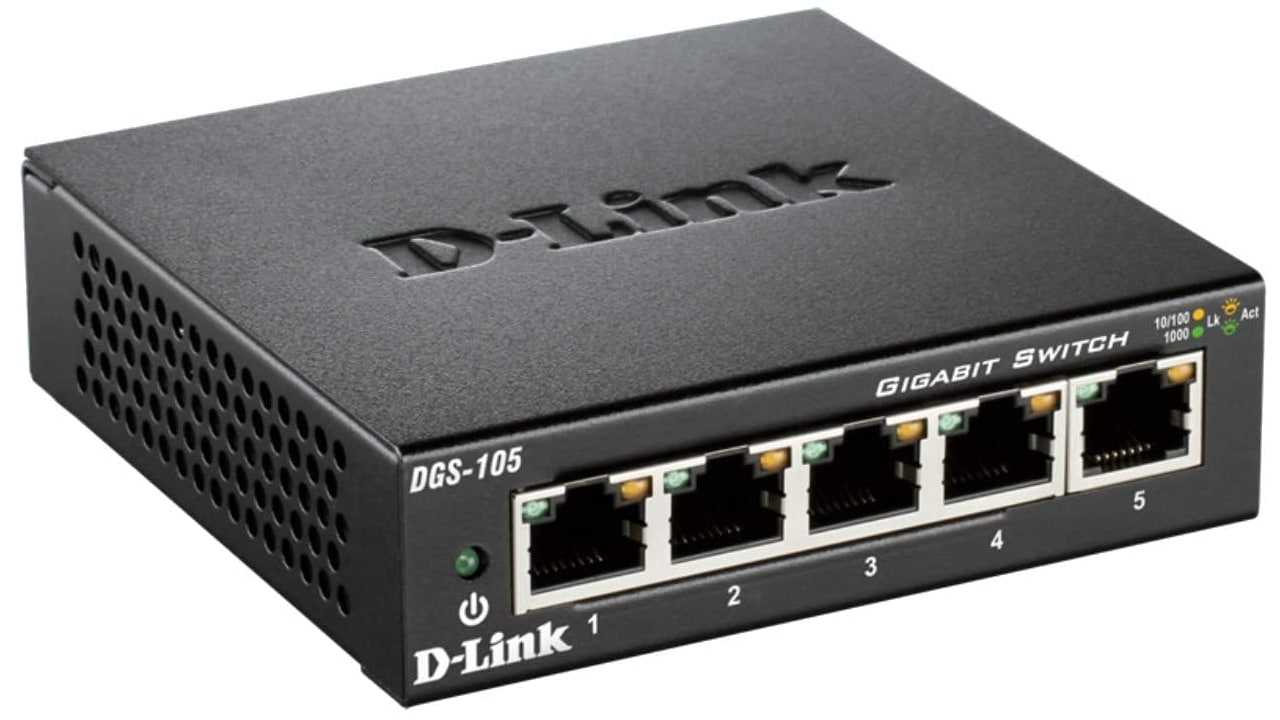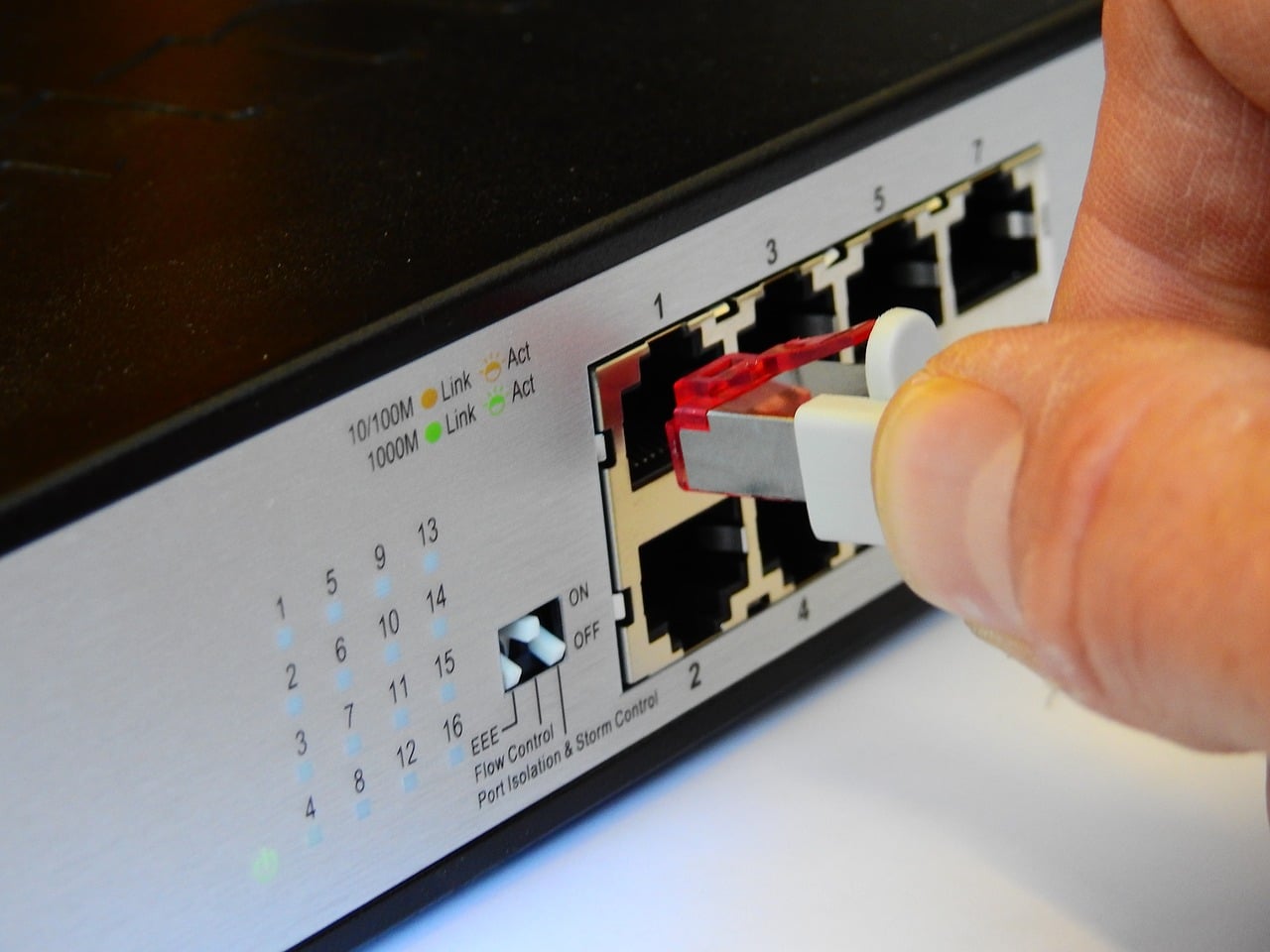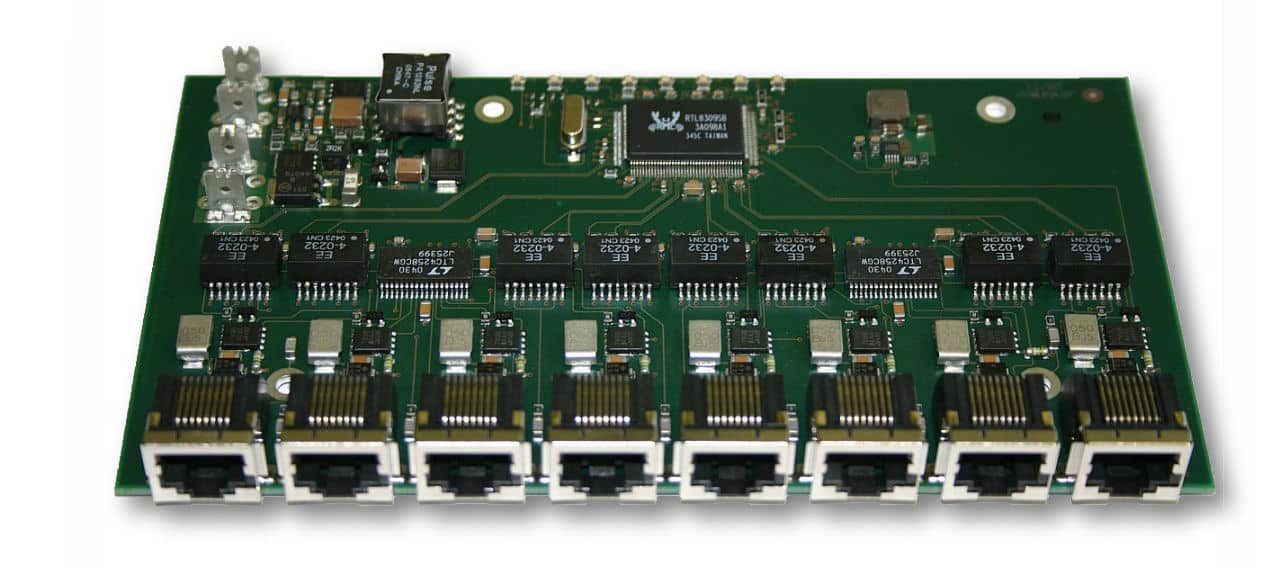There are many types of switches, one of them is the ethernet switch. A device that is widely used in some homes that need to connect several devices to the network by wiring, in offices, and also for servers. And, despite the fact that wireless networks have been imposed, there is still a lot of dependence on cabling.
If you need one of these network equipment, the truth is that they are quite simple for the most part, although there are also somewhat more advanced ones. Despite that, it is not easy choose the right one in some cases. If you have to know some technical details that will help you in the choice, as well as the best models that you can find in the market.
Best Ethernet switch models
These are some of the models that give the best results When it comes to an Ethernet switch for the home or office:
D-Link DXS-1100-10T
- 19 ”rack-mountable, business-class, high-performance, manageable network switch with 1U of ...
- It has 8 10 Gigabit Ethernet ports and 2 10 GbE SFP + ports
Saying D-Link DXS-1100-10T is using bigger words. It is true that it is one of the most expensive, but it is a professional device that can be a great complement for a company. This device supports speeds of up to 10 Gbps (NBASE-T) and fiber optics.
In addition, the switch has 8 10Gbit LAN ports (RJ-45), and 2 SFP + ports for fiber optics. And if that's not enough, it works with high performance and can even be mounted in a 19 ″ rack and occupies 1U height, for installation in server cabinets.
Also owns non-blocking technology to switch up to 200 Gbits per second without blocking between the different connected devices, and with a MAC table of up to 16.384 entries. The firmware of this device is also the best you can find on the market.
Netgear Nighthawk SX10
- 10G is 10 times faster than 1G - supports all multi-gigabit devices with the power they deserve
- Control latency and reduce lag spikes: optimized for gaming, bandwidth access limit per ...
Another of the best Ethernet switch models that you can find is el Netgear Nighthawk SX10. This is also a fairly professional model, although much more affordable than the previous one. It is ideal for offices or gaming due to its high performance and optimization (reduces latency) for these types of applications.
Su maximum speed is 10Gbps (NBASE-T) for 2 of its ports, to which we must add another 8 ports that work at 1Gbps. In this case, the firmware is also very good, with a multitude of functions and settings to choose from.
D Link DGS-108
- Metal chassis for greater resistance and better heat dissipation, which translates into greater ...
- Plug and play, no configuration required
If you're looking for something cheap for your home, then the D-Link DGS-108 is one of the best options for you. It is a team with good performance, great durability, and good heat dissipation thanks to its metal chassis that will allow you to work without rest without problems.
It has 1Gbps speed (1000BASE-T) with 8 ports. Its configuration is so extremely simple that you only need to connect and it will be working. And if you have Internet TV service, It has IGMP Snooping, so the performance will be assured so that there are no annoying drops.
TP-Link TL-SG108
- [8-port gigabit switch] - 8 45/10 / 100Mbps RJ1000 ports with automatic speed detection, support for ...
- Green ethernet technology saves energy consumption
An alternative to the previous D-Link is this TP-Link, equally cheap and perfect for homes or offices they don't need much. In this case, it has speeds of up to 1Gbps and 8 RJ-45 ports.
It also counts for IGMP snooping for those who use IPTV services, and it has also been equipped with a metal chassis that serves as a heat sink, to prevent it from getting hot when it is used intensively.
What is a switch?

Un switch, or switch, is a device that allows you to connect multiple devices to a network. That way, all devices can be connected to a local area network or LAN. Furthermore, the technical specifications, in this case, will follow the Ethernet standard (IEEE 802.3).
Differences between hub and swith
Act quickly. differentiate between a Hub and a Switch, since although they have very similar functions, the truth is that they have some differences. For example, in how Frames are sent. That is, the way in which the network frames that are transferred to transport the information are sent.
In the case of the hubs network, these frames, or series of bits, are sent to all devices connected to the hub equally. Instead, on switches they will only be sent to the target device. In other words, a hub would function as a typical electrical thief that makes one plug turn into several.
Instead, the switch, as its name suggests, behaves like a switch, switching between the different outputs to send the information to the appropriate device. Therefore, it has to have a somewhat more advanced hardware and endowed with an ability to recognize where it has to direct the information.
By exampleImagine that you have a PC connected to the switch, and a network printer. If some other connected device sends information to print a document, that information does not have to go to the PC's network adapter, but to the printer ...
How does a switch work?
Many of the networks that are connected through a switch have a star topology. That is, when using Ethernet LAN a configuration will be used where all devices are connected to a central switch.
As I mentioned, act with a switch thanks to its circuitry and processor. Therefore, they will send the network packets through the appropriate output. Each of the connected devices will not be receiving the same thing as a hub, but can act as if they were all connected to the router independently.
This is how you get it increased network scalability to connect more devices. Something very useful for connected devices both in homes, offices, and in large companies.
You also have to know that you can save a high bandwidth, since in a switch the data is not replicated through each of its ports as in the hub when two nodes are trying to communicate. The switch will use the MAC address of each connected device to identify them, and thus transmit the data between a sending node and a receiving node in a unique way.
On the other hand, in the hub the speed was adapted to the lower of the speeds connected devices when transmitting between them. That is not so in the other case ...
What do I need an Ethernet switch for?
The basic function is join or connect multiple devices to a network. But you should not confuse it with a router, since the Ethernet switch does not provide connectivity to other networks or to the Internet. In other words, for the devices to be connected to the Internet, the switch also needs to be connected to a router.
But when connecting multiple network devices via a switch, you can do things like:
- Share data between multiple connected computers.
- Use network printers.
- Make a router limited in ports to share its connection with many more devices thanks to the switch expanding the number of ports available.
Of course, if you connect a switch with your router, keep in mind that the connection speed of all connected devices will be limited by the speed of your network. That is, the switch will share the Internet speed, but it will not multiply it ...
Ethernet Switch Types
There are various types of Ethernet switches in the market. The most prominent are:
- desktop: they are the most basic, without any extra. They are the most used in the home. They usually have 4 to 8 ports. Their speeds are usually 1/10/100 Mbps, acting in the form of half-duplex and full-duplex.
- Unmanageable perimeter- Used for small medium throughput networks. They are somewhat larger and more expensive than the previous ones. In addition, they can have from 4 ports to 24 in some cases. Its speeds are 10/100 Mbps and up to 1Gbps.
- Manageable perimeter: similar to the previous ones, but for high-performance medium / large networks. Its ports range from 16 to 48, and have more advanced configuration speeds for more personalized management.
- Medium benefits trunks: they are used for medium networks with high performance and advanced functions. Some can also reach speeds of 10Gbps.
- High performance trunks: they are used in large data center servers and supercomputing (HPC). They are very expensive and advanced, their size is also quite large, and they offer very high speeds.
Buying Tips for Ethernet Switches
For choose a good Ethernet switch, you have to take into account a number of considerations. Considering these parameters, the purchase should be a success, without surprises or frustrating the device you have purchased due to any of its limitations.
Best Switch Brands
If you would like to a device that is reliable and lasts time when the workload is going to be heavy, then you should look for the best brands. Otherwise, you may be more concerned with glitches than actually enjoying what it has to offer.
All the best brands The ones I recommend are Cisco, Netgear, TP-Link, D-Link, Juniper, and ASUS. All of them offer very good qualities. So if you choose any of their models, you should not have too many problems during their use.
Speed
La speed The Ethernet switch may be different depending on the device, but you should always take into account the one you need according to the application to which you are going to use it. For example, it is not the same to use an Ethernet switch for a server, than for the home.
Surely you already know that there is Ethernet, Fast Ethernet, Gigabit Ethernet, etc. For the home and office, a Gigabit Ethernet (1000BASET-T) should be sufficient, since speeds of up to 1 Gbps are achieved. That is suitable for a multitude of apps and gaming. Instead, 10 Gigabit (10GbE) or higher will be required for business and other high-performance networks.
This type of technologies or standards They not only affect the speed, but also the type of medium through which it is transmitted, the maximum length of the cables, etc. For example:
- 10BASET-T- Ethernet standard using unshielded cat3 UTP cable with RJ-45 connectors. 10 indicates that it supports speeds of 10 Mbps. The maximum length is 100 meters for cabling. Above that it would cause problems.
- 1000BASET-TX: it is called Fast Ethernet, that is, with speeds of up to 100Mbps. Uses the same type of cat5, cat5e, and cat6 UTP cable, with maximum lengths of 100 meters.
- 1000BASE T- Uses UTB cat5 or higher cabling, up to 100 meters in length. The speeds in this case are 1000 Mbps or, what is the same, 1Gbps.
- 100BASE-FX: It is like 100BASE-T, but on fiber optic cabling. In this case the length is up to 412 meters.
- 1000BASE-X: It is like 1000BASE-T, but with fiber cable. You will find several subtypes, such as the SX, LX, EX, ZX, and CX, with slight differences. Depending on that, they can range from 25 meters of cable length, to even kilometers.
- 10GbE: also called XGbE. With several subtypes that can support both UTP cable and fiber optic for speeds of 10Gbps.
There are more standards and versions, but these are some of the most popular among the equipment you need for the home or office.
Port density
As you have seen, not all Ethernet switch models have the same number of ports. There are from 4 to several dozen of them. This is important when choosing the right one, since you have to anticipate the number of ports you need to connect to be able to have for all of them.
You can always buy a second Ethernet switch if you are missing, but that is not the most optical. So think about all the devices you are going to connect, both home automation devices, IoT, PCs, network printers, etc. Ideally, you should have the odd port to spare in case you decide to expand your repertoire of equipment in the future.
You also shouldn't buy a switch with too many ports, since its price is usually much higher and you will be wasting money that you will not be able to take advantage of. So, stop and evaluate what you really need.

By the way, some mid- and high-end switches offer modular ports without any specific port type. That allows you to buy separate port modules and thus adapt to any type. For example, you can install fiber optic modules, or modules for RJ-45, for RJ-11, etc.
In the low-end switches they already come with the ports directly, and in some cases of higher ranges as well. But if you come across one of these modular ports, you should know that there are GBICs (Gigabit Interface Converter) for UTP cables to Gigabit Ethernet; y the SFP (Small Form-factor Puggable), or mini-GBIC, which are used for Gigabit or 10GbE with fiber or UTP cable.
Manageability
When I have shown the Ethernet switch types, you have been able to verify that there are manageable and unmanageable. Well, those that are manageable are more expensive, but they allow greater configuration capacity. While the latter are cheaper and easier to use, but without much flexibility.
A non-manageable as well as cheap, it comes with a default configuration already established at the factory. This will simply connect them and start working, without you having to do anything. It is very comfortable, and the recommended ones for people who have no idea of network settings.
But if you want something more, a manageable has an advanced firmware that you can configure with a multitude of features (CLI, SNMP, VLAN, IP routing, IGMP Snooping, Link Aggregation, QoS,…). In addition, you can limit the bandwidth and make other configurations that will affect the performance and security of the network. That is why they are ideal for professionals or advanced networks.
Currently there are also some smart switches that allow managing some features at an intermediate price between non-manageable and manageable. They are very good for modern homes that need a little more than what a non-manageable offers, but with a cheap price.
firmware
When you choose an unmanageable, the firmware is a little less important. On the other hand, when it comes to a somewhat more advanced Ethernet switch, you must guarantee that the firmware is good. And especially that the provider of the network equipment does a good maintenance of it, that is, that it updates it constantly.
Una update firmware not only allows you to add some functions as some people think. It is something that can correct vulnerabilities that affect the security of your rd, correct bugs that affect the proper functioning of the computer, or improve performance in some cases.
Other characteristics
Finally also you should consider other extras that some models of network switches have. The most notable are:
- Buffer size: a buffer is a buffer, a kind of cache that stores data quickly for a certain time. This is how performance is improved. In the case of some switches, they also have these memories that store the frames that are going to be sent to a specific port. In addition, this allows the Ethernet switch to transfer between devices that work at different speeds without having to slow down, it only stores the data in this memory while the slower device has time to recover that data at its own pace. Make sure that the switch has good capacities of these temporary memories if you are going to use devices at different speeds ...
- PoE (Power over Ethernet) and PoE +: these are technologies supported by some switches and that allow the electrical power that these devices need to work to be supplied through the same LAN cable. That is, they would not need a separate power cord. This is not essential, but it can be good in cases where an Ethernet switch is to be installed in a location without sockets.
- SDN (Software Defined Networking): is a set of network techniques to implement software networks. Currently the most widely used open standard is OpenFlow. This allows you to configure networks, manage the data path that packets have to follow, remote management, etc. It is not something that is needed in many homes and offices, but it is when you want to configure somewhat more advanced networks.









